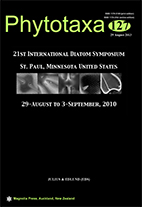Abstract
Previous knowledge of Cretaceous silicoflagellates has come primarily from scattered Maastrichtian or late Campanian localities. Silicoflagellates from the earlier Upper Cretaceous have been observed from the southern shore of the Baltic Sea and eastern slope of the northern Ural Mountains, and Lower Cretaceous from the Weddell Sea near Antarctica are also known. Much of the previous work, including type specimens for genera and species, have been illustrated with few and simple line drawings. Taxonomic distinctions and evolutionary lineages have often been speculative.
Recent studies of Santonian and lower Campanian marine sediments from several sites in the northern Canada Arctic Margin and Archipelago substantially increase our knowledge of Cretaceous silicoflagellate morphology, biostratigraphy, and early evolutionary history. This work, which develops from previous diatom studies, provides new information on the enigmatic genera Cornua and Variramus, describes new genera and species, and presents new information on the timing of silicoflagellate evolutionary events. Seven new biostratigraphic zones replace the previously applied single biostratigraphic unit for the Cretaceous.
This article reviews recent silicoflagellate discoveries in the context of previous work to provide a current general knowledge of the subject that includes important taxa.

